Hydraulic breakers are an ideal attachment to help break rock, concrete, asphalt and other construction and aggregate materials. However, to achieve long-lasting attachment performance, routine maintenance needs to be top of mind. And remember, safety comes first. Always wear suitable Personal Protective Equipment (PPE).
MAINTENANCE TIPS
1. Routine Walk-Around Inspection
Although it only takes a few minutes to visually inspect a hydraulic breaker for wear and tear, many operators overlook this step. A visual inspection should be completed each time the breaker will be used to help identify any worn or damaged components and prevent unexpected downtime.
Daily visual checks can give an early look at worn items that can lead to potential failures down the road. Check hydraulic hoses, the breaker shell, attachment pins, tool retainers and locks; and the tool point, for any cracks or gouges.
2. Inspect Breaker Bit, Pin, Bushing
Visually inspect for loose or broken bolts and worn out bushings. Keep an eye on tool and bushing wear. If the tool appears loose in the bushings, the play should be measured and recorded.
Any wear on the bushing can affect tool performance and should not be overlooked. Bushing wear will allow front to back play in the breaker tool and can cause misalignment to the piston.
Tool retaining pins are also subject to wear. The tool and tool retaining pins should be removed and inspected every week or 50 hours of operation. This interval could be longer or shorter depending on material and application. Look for damage in the retaining pin area, as well as determine whether the tool is receiving sufficient grease.
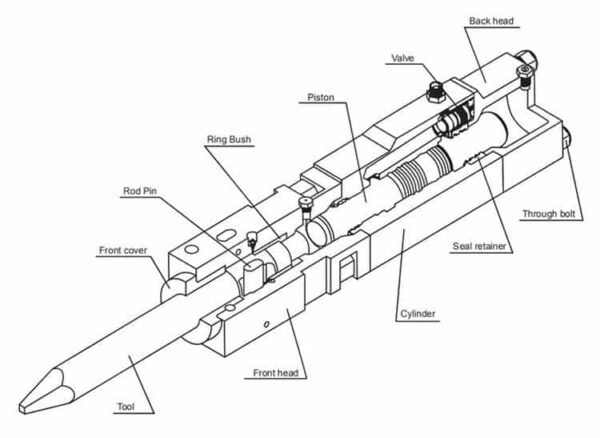
Worn out front bushings will cause misalignment between the piston and working steel. This may allow the piston to contact the inside cylinder wall during operation, thereby damaging the piston and cylinder — the two most expensive components of the breaker.
3. Inspect Hydraulic Hoses
Hydraulic hoses should be the correct length and always be routed properly to help decrease wear and potential downtime. Hhoses that are short in length restrict attachment extension. On the flip side, hoses longer in length can catch or become disengaged on rebar and other debris. MCM Breakers come with standard hydraulic hoses that are the correct length for each of our machines to make installation easy and maximize operating time and hose protection.
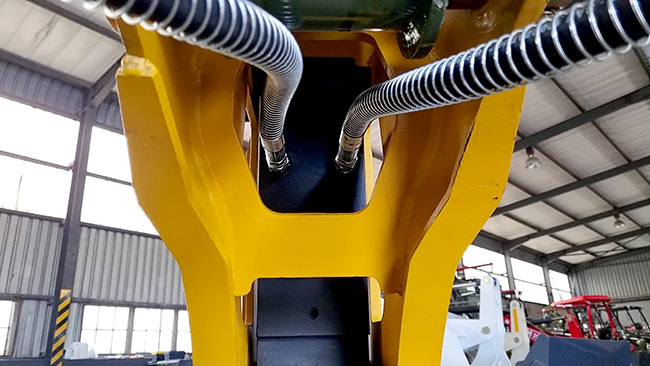
4. Applying Grease
Greasing is the most important maintenance task on a breaker. Grease performs a two-phase job: it lubricates and it clears the tool bushing area of debris.
Without lubrication, metal-to-metal contact between the breaker’s tool and bushing would cause the bushing to wear out quickly, subsequently exposing the breaker’s major components to serious damage. Although it’s highly unlikely that a contractor would ever completely forget about lubrication, a few key points on proper greasing are worth discussion.
Too much grease and you may get a buildup between the strike piston and the tool top. This absorbs striking force from the piston to the work tool. Too little grease, now you have a lapping compound once it is mixed with the dust.
The lubrication process begins by applying down pressure on the tool to ensure that it is pushed all the way into the breaker, eliminating the possibility of grease filling into a chamber between the piston and the top of the tool. Lubricant should be applied until it comes out of the lower bushing area, which indicates that the breaker cavity is full and ready to go to work. A paste or grease film should always appear on the tool at the lower bushing while the breaker is operational. The absence of grease is a good visual indication that it’s time to apply more lubricant.
Although the cost for chisel paste or special shank grease is higher than the price of regular grease, manual lubrication with paste is only required once every two hours on average, compared with one hour or less intervals using standard grease. So a chisel paste must be used that can handle high temperature and pressure. A chisel paste with a high-temp moly base that has graphite and copper additives is the best for this application.
MCM recommends a No. 2 lithium-based grease with three percent moly rated to 500 degrees Fahrenheit to help prevent metal-on-metal contact. Compared to standard lubricants, the grease is made for higher temperatures and remains between the steel and bushings at higher temperatures, providing for better and longer-lasting lubrication.
5. Inspect Nitrogen Pressure
While most understand the importance of lubrication and wear items, not all contractors may be aware that many hydraulic breakers feature a nitrogen gas assist that should also be maintained in the field as necessary. Expansion and contraction due to heating and cooling will lower the gas pressure in the breaker’s piston accumulator, much like the way that car tires will gradually lose air.
Unlike frequent greasing, gas pressure checks don’t need to be done on a daily basis. And unlike car tires, there’s nothing visual to suggest when the pressure should be checked. Instead, simply monitor the breaker’s performance. If there is a noticeable drop in the breaker’s power output, it could be an indication of low gas pressure.

Determining the proper nitrogen charge pressure depends on the application and outside working temperature. The nitrogen level for breaking rock should be different than breaking concrete in a parking lot. The outside temperature also adds another variable. The attachment’s Operation and Maintenance Manual gives you the recommended nitrogen pressure setting for your application and working temperature.
These gas charges should be checked for the appropriate pressure reading on a weekly bass, as a change in ambient temperature can affect the required pressure.
6. Size It Right
It’s also important to note that hydraulic breaker attachments are not universal across all carriers. Each breaker must be properly sized to a specific carrier’s performance to effectively break material. For instance, if a breaker is too large for the carrier, energy can be displaced and diminish the breaker’s impact on the material. If the breaker is too small, it can put excessive pressure on the working steel and other mounting components, potentially causing damage.
By following the above tips, you can better utilize your attachment on multiple job sites and help extend its life.
OPERATION GUIDELINES & TIPS
Principles of Breaking
To increase the working life of the breaker, correct working method must be adhered to, and the correct tool chosen for the job. There are essentially two ways
of breaking with a hydraulic breaker;
a. Penetrative Breaking (or Cutting)
In this form of breaking, a moil point or chisel tool is forced into the material. This method is most effective in soft, layered or plastic, low abrasive materials.

b. Impact Breaking
With impact breaking, the material is broken by transferring very strong mechanical stress waves from the tool into the material. The best possible energy transfer between the tool and the object is achieved with a blunt tool. Impact breaking is most effective in hard, brittle and very abrasive materials. The use of a point tool in hard material will cause the sharp edge to wear very quickly.

Operator Guidelines
1. Avoid Blank Firing
Blank firing is a common problem that can affect the longevity of a breaker. It occurs immediately after material is broken when the tool fires against itself, as there is no material beneath it. If the energy from this blow is not absorbed by the rock or concrete, the breaker itself ends up absorbing the force, which can cause unnecessary wear to components.
2. Work In Short Bursts
An important practice to follow in the field is to use a breaker only in short bursts. Running a breaker continuously for more than 15–30 seconds can cause extreme heat build-up and warp the tool, which ultimately decreases performance and productivity. Additionally, breaking is highly effective during the first 10 seconds and becomes very ineffective after 30 seconds, so regular repositioning is required to protect the machine.
3. Operate Perpendicular To Material
This may be vertical, horizontal or anywhere in between as long as the tool is perpendicular to the surface. Hammer operation that is less than 90° can cause ‘side loading’ and accelerate internal component wear and cause premature failure of the hammer.
Also avoid starting breaking of large objects or slabs from the center of the material. Start at the outer edges and work your way inward.
4. A Breaker Is Not A Pry Bar or Jib
It is not uncommon for some operators to use the tool on a breaker to pry concrete or rock into a better position. This is one of the worst practices an operator can engage in when it comes to keeping a breaker in optimal condition. Using the hammer as a pry bar causes damage and premature wear.
Never attach a cable or sling to the breaker to hoist a load. Doing so is extremely dangerous.

5. Never Use In or Under Water
If water is allowed to penetrate the percussion chamber, each blow creates a pressure wave. These pressure waves cause irreparable damage to the stripper and seals of breaker. Also the lower percussion piston zone would rust. Water could also penetrate the carrier’s hydraulic system. In order to avoid damage to the hydraulic breaker
6. Proper Storage
Properly storing a breaker is just as important as regular maintenance. The seals that separate the hydraulics are typically located around the strike piston. When the breaker lies horizontally, the strike piston puts weight on those seals, distorting them. Once that takes place, the fluids tend to leak out.
When it comes to long-term storage, storing the breaker in a climate-controlled environment is always best. Properly cap all hydraulic ports and coat any bare metal surfaces with some type of anti-corrosive agent such as grease or anti-seize.
7. Additional Guidelines & Conclusion
- The use of the attachment should never lift the carrier off the ground.
- The head should always be able to move freely.
- When working in a trench, never allow the breaker to hit trench walls.
- Be aware of flying debris – use protective eye wear, make sure protective window or screen is available for operator.
Give a breaker the time and attention it deserves, and it will return the favor with productive and impressive results.

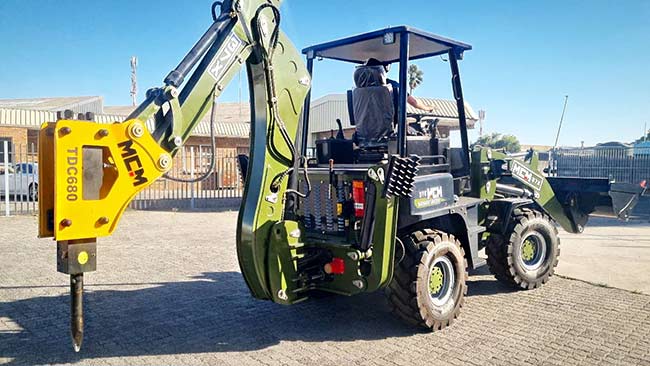

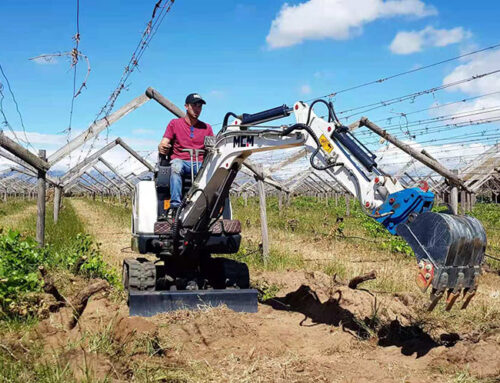
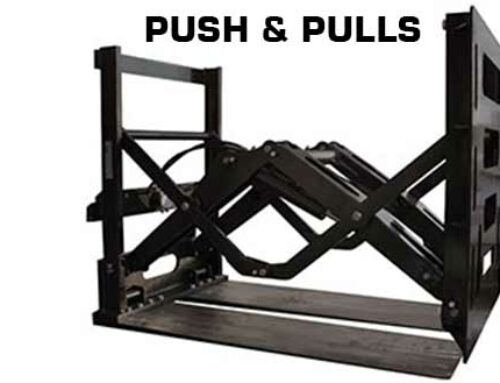
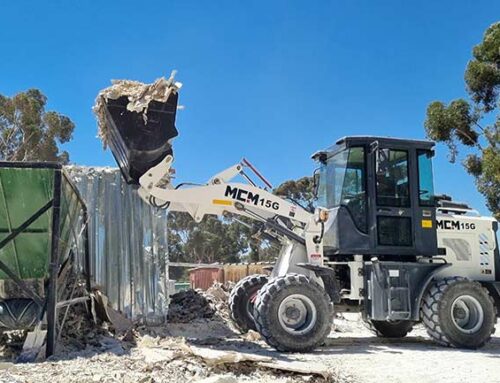
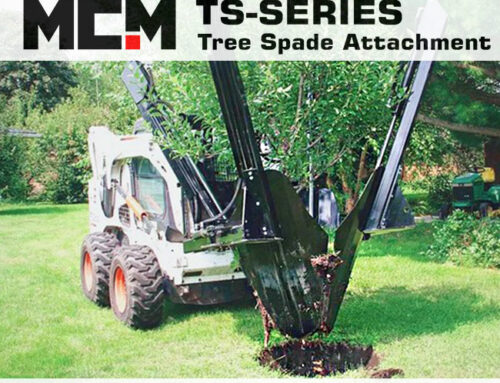
Leave A Comment